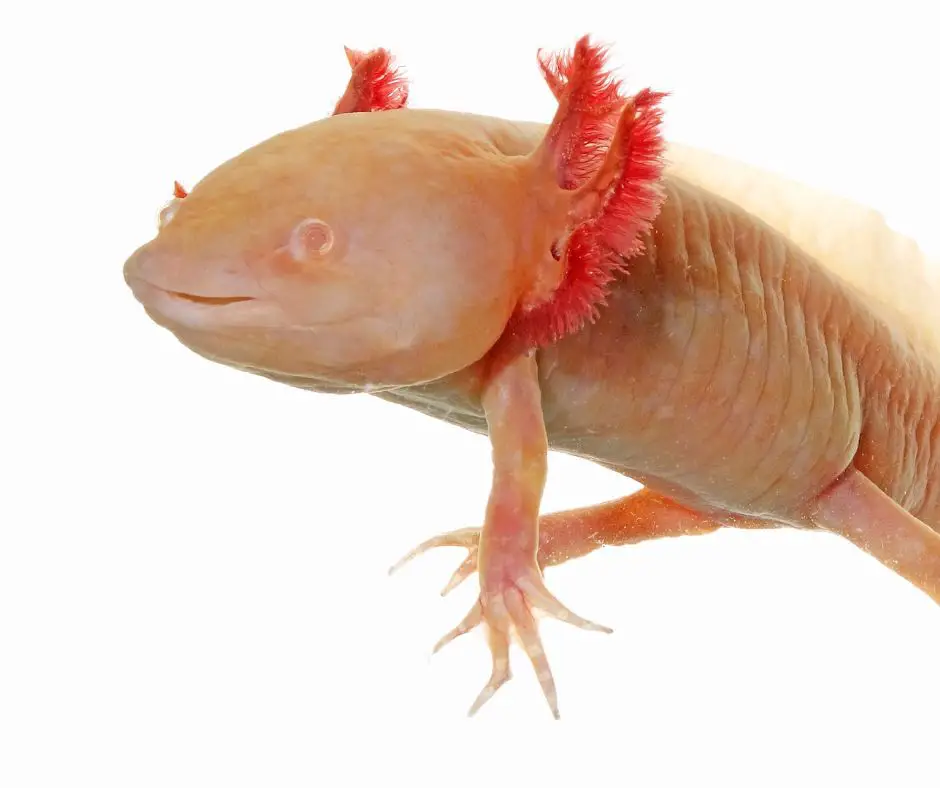Fungal infections are pretty common in axolotls, in part because these salamanders are cold water animals.
Fluffy, cotton-like fungus appears on axolotl’s gills and feet. If left untreated, the infections can lead to serious complications.
Many axolotl owners wonder how to address this issue. Fortunately, in most cases, fungal infections in axolotls are treatable, even preventable.
In this post, we are going to discuss everything you need to know about the causes, treatment options, and preventative measures for axolotl fungus on feet.
Hopefully you will find some useful information and tips here.
Contents
Axolotl Fungus on Feet: Cause, Treatment and Prevention
The signs of fungal infections in axolotls are easy to detect. White spots appear on legs, gills or anywhere on the axolotl’s body, even on the eyes.
The density of the spots depends on the severity of the condition. Warm water, poor water quality, and stress are the most likely cause of this disease.
Fridging and salt baths are the most effective treatment options.

Axolotl Foot Fungus Causes
Axolotl foot fungus is usually related to illness or stress. The major causes of this problem include inappropriate tank water parameters and temperatures, and poor nutrition.
Poor water quality can weaken your axolotl’s immune system, making the animal susceptible to fungal infections.
If your axolotl stays in water that has too much dissolved organics and high levels of toxicity, the animal’s immunity will be compromised.
In axolotls, fungal infections can also result from subclinical illnesses.
How to Treat Foot Fungus for Your Axolotl
First of all, make sure the tank water is clean, and offer a balanced diet to your axolotl.
Most importantly, address the root causes of infection, such as wrong temperatures, poor water quality, or pH problems.
In some cases, changing the tank water is enough to fix the fungus issue. If the fungus has affected only a small area of your axolotl’s body, you have to fridge the animal.
Fridging is effective because the process slows down the growth of fungi, bacteria, viruses, and protozoa.
Once your axolotl has undergone the process of fridging, chances are that its foot fungus will be gone.
For this process, the temperature of the fridge should be set at 5.5-9°C. Keep your axolotl in a container filled with freshwater, and then place the container in the fridge.
It is important to take care of the animal when fridging. Maintenance involves feeding the axolotl and changing water. Learn how to fridge axolotl and then just follow the steps.
The container can be left in the fridge for as long as 3 weeks. However, you will notice the benefits in just a week. The foot fungus will gradually disappear.
If the conditions are more severe, you may consider applying a salt bath. The treatment can effectively remove fluffy, cotton-like fungus, and is usually safe when applied appropriately.
In short, the process involves adding salt to water and dipping your axolotl in the water for 10 to 15 minutes.
Non-iodized salt is necessary for a salt bath. If the salt is iodized, it will cause harm to your axolotl. Aquarium salt, sea salt or rock salt can be used for a salt bath.
Learn more about axolotl fungus treatment and then opt for a treatment option that’s safe and suitable for your axolotl.
API Aquarium Salt
- Contains one (1) API AQUARIUM SALT Freshwater Aquarium Salt 65-Ounce Box
- Promotes fish health and disease recovery with increased electrolytes
- Improves respiration for fish in freshwater aquariums
- Made from evaporated sea water for all-natural results
- Use when changing water, when setting up a new freshwater aquarium and when treating fish disease
Last update on 2022-12-29 / Affiliate links / Images from Amazon Product Advertising API
Preventing Axolotl Foot Fungus
Preventing fungus is actually easier than treating the condition. Just address the factors that contribute to the growth and proliferation of fungus, such as poor water quality.
Make sure you test your tank water parameters every week.
A cycled tank should be tested twice a week. Keep a thermometer in the tank so that you can easily monitor the temperature of the tank water.
Check out: How To Cycle Tank For Axolotl: 7 Steps for Beginners
Axolotl Fungus on Feet and Related Problems

Axolotl fungus can manifest in several different ways, and the treatment method should be determined by the symptoms.
If white fungus appears on your axolotl’s gills, the infections are caused by a fungus called saprolegnia, which thrives in cold water.
To treat the problem, consider slightly raising the temperature of the tank water. Also, try salt baths. Your axolotl may need multiple salt baths before the fungus disappears.
Your axolotl may also flap its gills when there are fungal infections. However, this behavior may be normal if it doesn’t accompany other signs of fungal infections.
The animal can do it to intake oxygen or move water through the gills. If the problem is caused by fungus, you can beat it by changing the water and performing salt baths.
Look at the legs of your axolotl. If they are red, chances are that there is severe secondary infection. If this is the case with your pet, consider fridging the animal. This process will slow down the spread of infection.
After that, if the infection persists, you can try other treatment methods, such as tea baths or salt baths.
Also read: Types of Axolotl Bath: Complete Guide for Beginner
VIVOSUN 1-Pack LCD Digital Aquarium Thermometer
- High Accuracy: Temperature Range: -50℃ ~ +70℃ (-58 °F ~ +158 °F); This aquarium thermometer is accurate to +/- 1℃, no matter whether the probe is placed in any corner of this fish tank, an accurate temperature will be displayed
- LCD Display: Comes with a large LCD display that is easy to read clearly and accurately
- Adjustable Unit Tempature: Easy to adjust the temp between Fahrenheit and Celsius displays; Long-press the power button to adjust the unit display
- Two Suction Cups: Equipped with two suction cups, one for attaching the cable to the side of the tank and another for attaching the thermometer
- Super Long Cable: The cable length connected to the probe is 78.74 inch (2 m) superior to 23.62 inch (60 cm) standard cable length; Allows accurate temperature measurements in even the largest fish tanks
Last update on 2022-12-29 / Affiliate links / Images from Amazon Product Advertising API
FAQs
How do you treat axolotl fungus?
There are several different ways to treat axolotl fungus. Changing the tank water, raising or lowering water temperature, and doing tea baths and salt baths are the most common treatments for fungal infections in axolotls. You have to opt for a treatment method depending on the severity of the condition.
What is the white stuff on my axolotl?
It’s fungus, most likely caused by stress, warm water, or poor water quality. If left untreated, the condition intensifies and the white, cotton-like stuff becomes more prominently visible. In a severe case, your axolotl’s life will be at stake.
How do you treat axolotl bacterial infection?
Bacterial infections are often treated with antibiotics such as florfenicol, sulfonamide, and chloramphenicol. However, there are some other treatments that are pretty effective and safe. Salt baths and fridging are two effective treatments for fungal infections in axolotls.
How do I know if my axolotl is dying?
There are some signs and symptoms that indicate that your axolotl is very sick or about to die. These symptoms include poor balance while swimming, back deformities, deterioration of the gills, skin lesions, and loss of appetite.
Wrapping Up
Fungal infections can severely affect the health and well-being of your axolotl. But the good news is, the problem can be cured if diagnosed in time.
Better yet, by ensuring the ideal temperature and parameters of the tank water, and being careful about what food you offer to your little friend, you can even prevent the condition.


